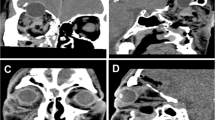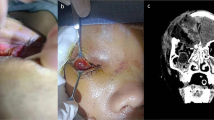Abstract
Introduction
Development of a posttraumatic herniation of brain parenchyma through the orbit is a rare complication of orbital roof fracture. Mostly, the injury is due to a direct impact to the frontal region resulting in orbital roof fracture with dural defect and herniation of cerebrospinal fluid or brain parenchyma. These patients present with acute or gradually progressive proptosis with impending risk of loss of vision and mandate surgical decompression of optic nerve with watertight closure of the dural defect. Bony reconstruction may be required to achieve normal contour of the orbit.
Materials and methods
We encountered an interesting pediatric patient who presented to us with altered sensorium and progressive proptosis 3 days after a penetrating trauma to his left orbit by falling on the handle of a bicycle. The plain computerized tomography of the head (NCCT) showed a left orbital roof defect with herniation of brain matter into the orbit displacing the globe inferolaterally. A craniotomy was performed and watertight closure of the dural rent was achieved with use of autologous bone to cover the defect.
Conclusions
The child improved gradually, and at 6 months follow-up, he had good cosmetic outcome with improvement of vision.

Similar content being viewed by others
References
Antonelli V, Cremonini AM, Campobassi A, Pascarella R, Zofrea G, Servadei F (2002) Traumatic encephalocele related to orbital roof fractures: report of six cases and literature review. Surg Neurol 57(2):117–125.
Suri A, Mahapatra AK (2002) Growing fractures of the orbital roof. A report of two cases and a review. Pediatr Neurosurg 36:96–100. https://doi.org/10.1159/000048360
Sahoo SK, Salunke PS, Ghuman MS (2014) Traumatic orbital encephalocele in an infant: using the fracture line to our advantage. Acta Neurochir 156(7):1357–1359. https://doi.org/10.1007/s00701-014-2002-3
Mokal NJ, Desai MF (2012) Titanium mesh reconstruction of orbital roof fracture with traumatic encephalocele: a case report and review of literature. Craniomaxillofac Trauma Reconstr. 5(1):11–18. https://doi.org/10.1055/s-0031-1300958
Arslan E, Arslan S, Kalkısım S, Arslan A, Kuzeyli K (2016) Long-term results of orbital roof repair with titanium mesh in a case of traumatic intraorbital encephalocele: a case report and review of literature. Craniomaxillofac Trauma Reconstr 9(3):255–259. https://doi.org/10.1055/s-0036-1581064
Author information
Authors and Affiliations
Corresponding author
Ethics declarations
Conflict of interest
On behalf of all authors, the corresponding author states that there is no conflict of interest.
Rights and permissions
About this article
Cite this article
Vankipuram, S., Srivastava, C., Ojha, B.K. et al. Penetrating orbital trauma leading to trans-orbital brain herniation. Childs Nerv Syst 34, 373–375 (2018). https://doi.org/10.1007/s00381-017-3600-1
Received:
Accepted:
Published:
Issue Date:
DOI: https://doi.org/10.1007/s00381-017-3600-1




